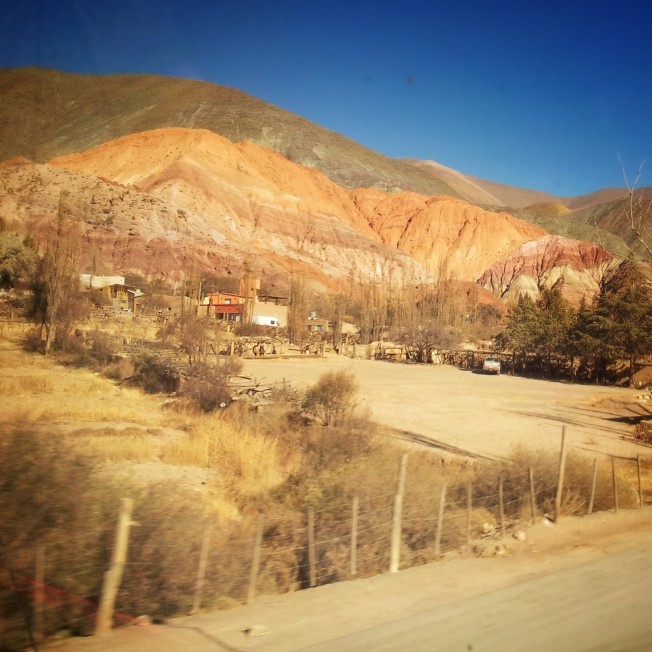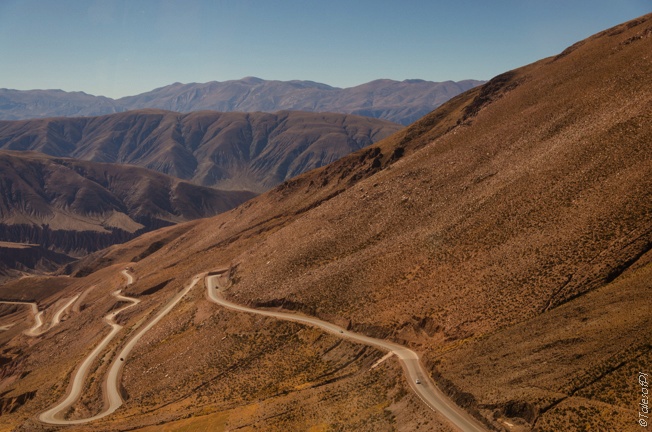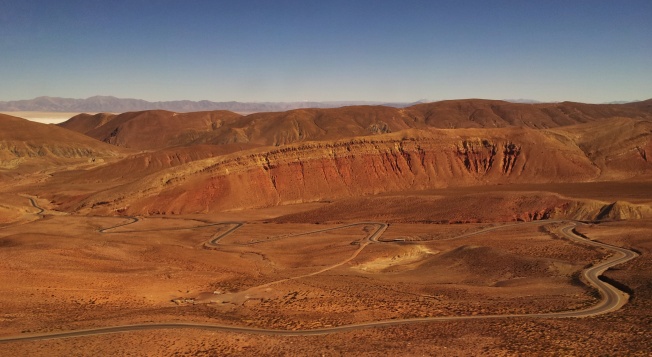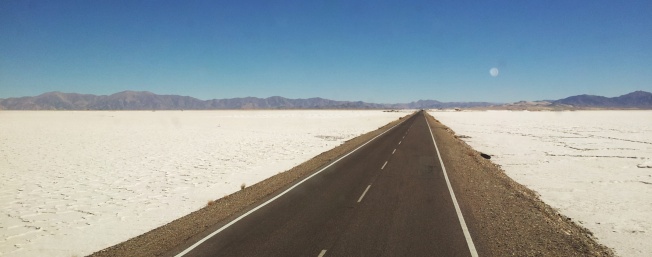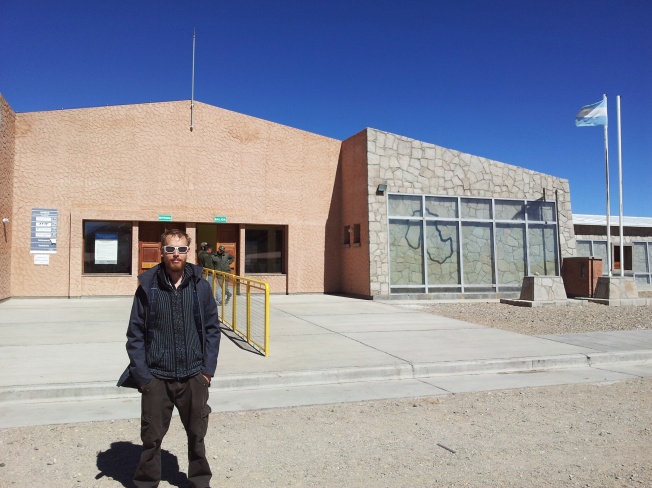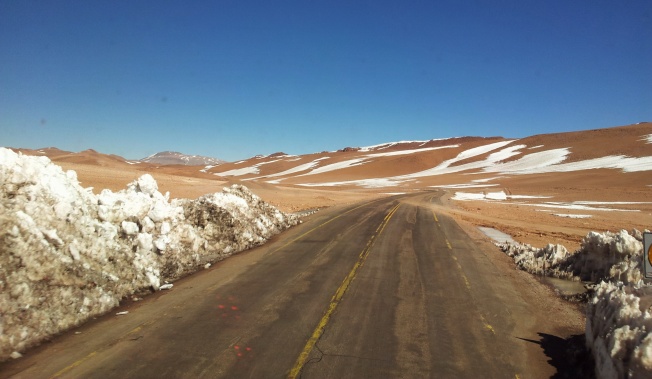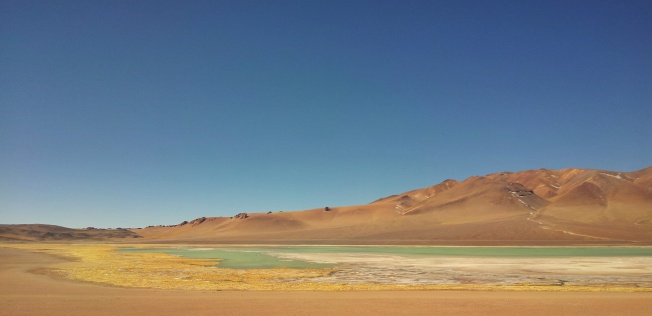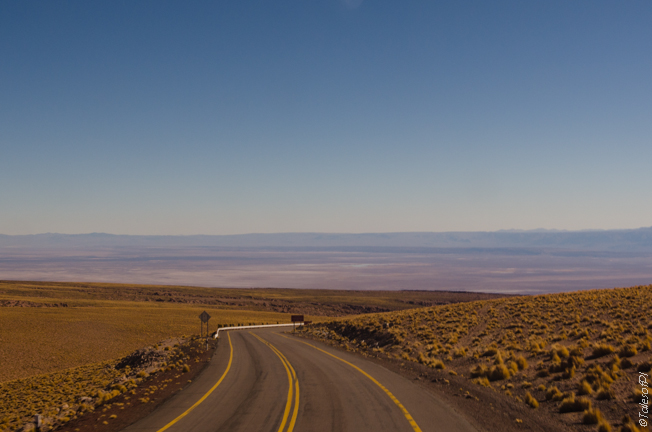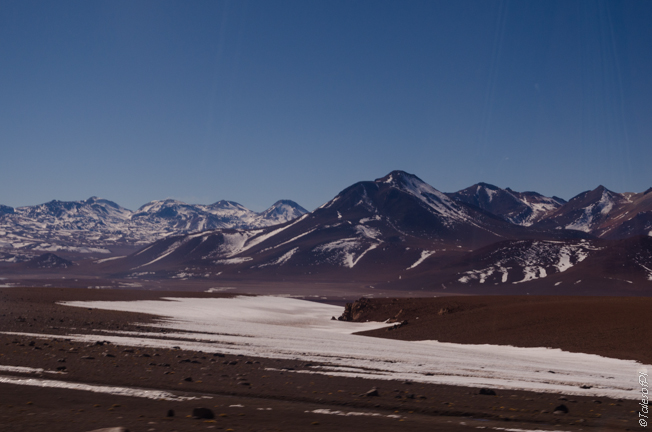 When thinking of the bus ride from Salta to San Pedro de Atacama the following words and phrases come to mind; beautiful, long, incredible colours, foreign landscapes, gruelling!
When thinking of the bus ride from Salta to San Pedro de Atacama the following words and phrases come to mind; beautiful, long, incredible colours, foreign landscapes, gruelling!
We left Salta at 7am and made our way north to Jujuy for the first stop. We made another stop to pick up some more travelers at Purmamarca which gave us a chance to see the Hill of 7 Colours.
From there the bus winds its way up through enormous green valleys until it takes a detour straight up into the mountains along La Cuesta de Lipan – a 17km stretch of winding road that rises 1970m up from the edge of the town of Purmamarca. It is an amazing engineering accomplishment and quite a scary ride at the same time. It seems as if the road is one long snake hugging the mountain side coiling over and over itself and there are countless switchbacks until we climb over the pass 4170m asl and on the other side get a glimpse of Salinas Grandes, the salt flat attraction in Salta province.
The bus then heads down towards and right through the salt flat and for a moment it appears as if the white salt goes on forever.
We carried on climbing for another couple hours until we reach the remote Argentinian border post for a security check which was no more than a quick look at our passports. The landscape had become dry and arid with very few little shrubs and bushes dotted around and we could really feel a difference in air density from the altitude when getting off the bus. After that its we carried on straight towards massive old volcanoes and mountain peaks on the road towards Paso de Jama (Jama Pass – 4200m asl) and into no-mans land (literally no one lives out there) as the bus continues to climb up towards the Chilean part of the Altiplano (Andean highland plateau). There’s no real boundary between the two countries and the Chilean border control is actually on the edge of the town of San Pedro de Atacama another 160kms away. I later asked one of the local guides in San Pedro why they don’t check the people coming in from Argentina closer to the Argentinian border post and he said, “No one can live out there and there’s nowhere else to go but here!” He was right. Heading further up towards the pass we could see the remnants of a recent hefty snowfall with some snow drifts sometimes piled up 2 or 3 metres on the side of the road. Apparently the pass was closed the week before we went over. Up through the snow and over the Paso de Jama (4200m asl) we entered the Altiplano and amazingly the bus keeps heading towards the volcanoes and climbing even higher. This is when the altitude was really taking its toll on us.
It had been recommended by our host in Salta that we buy Acetazolomide (Diamox) tablets for the altitude sickness and also chew coca leaves which the indigenous peoples had been doing for centuries. We had some coca leaves for the first part of the journey but weren’t sure of the immigration policies so we dumped our leaves at the Argentinian border post. It turns out that everyone has some and it’s not a problem taking some leaves across the border. Damn! Now the problem with the Acetazolomide tablets are (as it so nicely explains on the sheet with the tablets) is that the side effects are headaches, drowsiness, nausea and slight muscular aches, among others, which is a bit ridiculous as that is what happens when you get the altitude sickness! As recommended we took some tablets the day before leaving to try them and also as a preventative measure and all those symptoms hit us quite hard so we didn’t want to take more during the journey and risk it being worse when we were on the bus. So over the pass we went and honestly the best thing you can do to help is try to relax and drink water. Lots of water. Throughout the 11 hour journey we finished off over 8 litres between us and could’ve still drank some more.
Once the road flattens out over 4500m asl it really feels as if you’ve arrived on another planet. The route passes between old volcanos and along some barren plains and the surrounding landscape seems destitute of all life until you pass by one of the stunning lagoons peacefully nestled between a few high peaks. The beautiful lagoons shine bright colours of green, blue and turquoise in a landscape dominated by brown and black rocks and a reddish sand. Not far from the lagoons you’ll be sure to spot some vicunas (the Llamas smaller, thinner cousin).
This incredible contrasting scenery goes on for another couple hours until you head past the massive snow-capped volcano Licancabur which is neatly nestled between Chile and Bolivia. Just past that you start making your way down (thankfully!) towards San Pedro de Atacama which itself is situated on the edge of a massive dried up lagoon, the Salar de Atacama. That view in itself was worth the journey but it was the whole experience of the vastly contrasting landscapes and amazing scenery that made it one unforgettable bus ride. Stepping out of the bus was such a relief and it felt good to have the hot desert sun warm us up.

